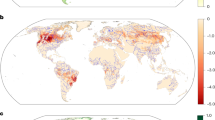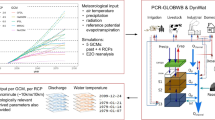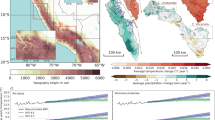Abstract
Water availability on the continents is important for human health1,2, economic activity3, ecosystem function4 and geophysical processes5. Because the saturation vapour pressure of water in air is highly sensitive to temperature, perturbations in the global water cycle are expected to accompany climate warming6. Regional patterns of warming-induced changes in surface hydroclimate are complex and less certain than those in temperature, however, with both regional increases and decreases expected in precipitation and runoff. Here we show that an ensemble of 12 climate models exhibits qualitative and statistically significant skill in simulating observed regional patterns of twentieth-century multidecadal changes in streamflow. These models project 10–40% increases in runoff in eastern equatorial Africa, the La Plata basin and high-latitude North America and Eurasia, and 10–30% decreases in runoff in southern Africa, southern Europe, the Middle East and mid-latitude western North America by the year 2050. Such changes in sustainable water availability would have considerable regional-scale consequences for economies as well as ecosystems.
This is a preview of subscription content, access via your institution
Access options
Subscribe to this journal
Receive 51 print issues and online access
$199.00 per year
only $3.90 per issue
Buy this article
- Purchase on Springer Link
- Instant access to full article PDF
Prices may be subject to local taxes which are calculated during checkout




Similar content being viewed by others
References
Reiter, L., Falk, H., Groat, C. & Coussens, C. M. (eds) From Source Water to Drinking Water: Workshop Summary (National Academies Press, Washington DC, 2004)
United Nations Educational Scientific and Cultural Organization. Water for People—Water for Life, The United Nations World Water Development Report (Berghahn Books, Oxford, 2003)
Shiklomanov, I. A. & Rodda, J. C. (eds) World Water Resources at the Beginning of the 21st Century (Cambridge Univ. Press, Cambridge, 2003)
Mooney, H., Cropper, A. & Reid, W. Confronting the human dilemma. Nature 434, 561–562 (2005)
Cazenave, A. et al. Space techniques used to measure change in terrestrial waters. Eos 48, 59 (2004)
Allen, M. & Ingram, W. J. Constraints on future changes in climate and the hydrologic cycle. Nature 419, 224–232 (2002)
Brockwell, P. J. & Davis, R. A. Time Series: Theory and Methods Ch. 7 (Springer, New York, 1987)
Manabe, S., Wetherald, R. T., Milly, P. C. D., Delworth, T. L. & Stouffer, R. J. Century-scale change in water availability: CO2-quadrupling experiment. Clim. Change 64, 59–76 (2004)
Fekete, B. M., Vörösmarty, C. J. & Grabs, W. High-resolution fields of global runoff combining observed river discharge and simulated water balances. Glob. Biogeochem. Cycles 16 (2002); published online 7 August 2002 (doi:10.1029/1999GB001254)
Siebert, S., Döll, P., Feick, S. & Hoogeveen, J. Global Map of Irrigated Areas version 2.2 (Johann Wolfgang Goethe University, Frankfurt am Main, Germany; Food and Agriculture Organization of the United Nations, Rome, 2005)
Darnell, W. L. et al. Surface Radiation Budget: A Long-term Global Dataset of Shortwave and Longwave Fluxes [online] http://www.agu.org/eos_elec/95206e.html (1996).
Adler, R. F. et al. The Version 2 Global Precipitation Climatology Project (GPCP) monthly precipitation analysis (1979–present). J. Hydrometeorol. 4, 1147–1167 (2003)
Vörösmarty, C. J., Fekete, B. M., Meybeck, M. & Lammers, R. B. Global system of rivers: Its role in organizing continental land mass and defining land-to-ocean linkages. Glob. Biogeochem. Cycles 14, 599–621 (2000)
Acknowledgements
We thank T. Cohn, T. Delworth, I. Held, G. Hodgkins, H. Lins and R. Stouffer for advice. Streamflow data were provided by national hydrometric services through the Global Runoff Data Centre, Koblenz, Germany. Climate-model outputs were provided by modelling centres through PCMDI. We acknowledge the JSC/CLIVAR Working Group on Coupled Modelling and their Coupled Model Intercomparison Project and Climate Simulation Panel for organizing the model data analysis activity, and the IPCC WG1 TSU for technical support. This investigation was performed within the IPCC Global Hydroclimates Analysis Project.
Author information
Authors and Affiliations
Corresponding author
Ethics declarations
Competing interests
Reprints and permissions information is available at npg.nature.com/reprintsandpermissions. The authors declare no competing financial interests.
Rights and permissions
About this article
Cite this article
Milly, P., Dunne, K. & Vecchia, A. Global pattern of trends in streamflow and water availability in a changing climate. Nature 438, 347–350 (2005). https://doi.org/10.1038/nature04312
Received:
Accepted:
Issue Date:
DOI: https://doi.org/10.1038/nature04312
This article is cited by
-
SWAT based analysis of multiple GCM models for predicting the long-term effects on various hydrometeorological components of a dam-to-dam river basin
Stochastic Environmental Research and Risk Assessment (2024)
-
Modern anthropogenic drought in Central Brazil unprecedented during last 700 years
Nature Communications (2024)
-
Leveraging global climate models to assess multi-year hydrologic drought
npj Climate and Atmospheric Science (2023)
-
Southeast Asian ecological dependency on Tibetan Plateau streamflow over the last millennium
Nature Geoscience (2023)
-
Future global streamflow declines are probably more severe than previously estimated
Nature Water (2023)
Comments
By submitting a comment you agree to abide by our Terms and Community Guidelines. If you find something abusive or that does not comply with our terms or guidelines please flag it as inappropriate.



